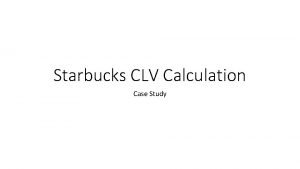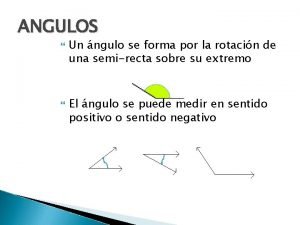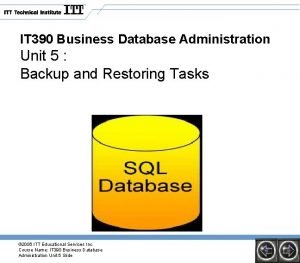Entrepreneurship for Computer Science CS 15 390 LTV























- Slides: 23

Entrepreneurship for Computer Science CS 15 -390 LTV- Part II Lecture 14, March 19, 2019 Mohammad Hammoud

Today… • Last Session: • Lifetime value of an acquired customer (LTV)- Part I • Today’s Session: • LTV- Part II • Announcements: • Mid-semester grades are out • M 3 of the project is due on March 28 by midnight • Next lecture will be delivered by Elijah Mayfield, an Entrepreneur-in. Residence at Project Olympus in the School of Computer Science at CMU-P

Outline Net Present Value LTV Calculation ü

Present Value: Recap • Present value is the result of discounting future value to the present • In general, its formula can be stated as follows: • PV = FV/(1+r)n, where • • PV = Present Value FV = Future Value r = Discount Rate (or rate of return) n = Number of Periods, which could be in years, months, weeks, etc. • Related to the concept of the present value is the net present value

Net Present Value • Assume you want to invest in a business $10, 000 • Can you pay off this investment in 3 years, assuming a discount rate of 5%? Cash Outflow Year 0 Year 1 Year 2 Year 3 Cash Inflow $10, 000 $3, 000 There is a Time Value of Money (e. g. , $10 today worth more than $10 in a year) because of inflation and earnings that could be potentially made using the money during the intervening time; hence, discount! $4, 000 $5, 000

Net Present Value • Assume you want to invest in a business $10, 000 • Can you pay off this investment in 3 years, assuming a discount rate of 5%? Cash Outflow Year 0 Year 1 Year 2 Year 3 $10, 000 Cash Inflow $3, 000/1. 05 = $2857. 14 $4, 000/1. 052 = $3628. 11 $5, 000/1. 053 = $4319. 18 $3, 000 $4, 000 $5, 000

Net Present Value • Assume you want to invest in a business $10, 000 • Can you pay off this investment in 3 years, assuming a discount rate of 5%? Cash Outflow Year 0 Year 1 Year 2 Year 3 $10, 000 Cash Inflow $2857. 14 $3628. 11 $4319. 18 $3, 000 $4, 000 $5, 000 $10804. 44

Net Present Value • Assume you want to invest in a business $10, 000 • Can you pay off this investment in 3 years, assuming a discount rate of 5%? Cash Outflow Year 0 Year 1 Year 2 Year 3 $10, 000 $10804. 44 – $10, 000 = 804. 44 ü YES, you can pay off your investment in 3 years

Net Present Value •

Outline Net Present Value LTV Calculation ü

Key Inputs to Calculate LTV 1. Revenue channels • This depends on your business model • E. g. , One-time, up-front revenue channel, if any • E. g. , Recurring revenue stream, like subscription fee, maintenance fee, or purchases of consumables, if any • E. g. , Additional revenue opportunities like revenue from add-on products, if any 2. Gross margin for each of your revenue channels • Gross margin = price – production cost • Note: “Production” cost does not include sales, marketing, administrative, and overhead (e. g. , R&D) costs

Key Inputs to Calculate LTV 3. Retention rate • This is the percentage of customers who will continue to pay for your product 4. Life of product • This is the duration you expect your product will last before the customer either discontinues using it or purchases a replacement 5. Next product purchase rate • This is the percentage of customers who will buy a replacement product from you when the life of the current product ends

Key Inputs to Calculate LTV 6. Cost of capital rate for your business • This is how much it costs you (in debt or equity) to get money from investors for your business (it is actually the discount rate) • For a new entrepreneur who lacks a track record and is just starting, an appropriate number is between 35% and 75% (also, the riskier your venture is, the higher the number)

How to Calculate LTV? • Algorithm: 1. for each year y 2. for each revenue channel in your business model 3. if in y the customer will replace your product 4. use “gross margin”, “retention rate” (if any), and 5. “next product purchase rate” to calculate your profit p 6. else 7. use “gross margin” and “retention rate” (if any) 8. to calculate your profit p 9. total_profit += p 10. calculate the present value pv of total_profit in y 11. LTV += pv 12. total_profit = 0

Example: “Widget” • Assume a conceptual case of a company that makes a “widget” • Widget’s business model involves a one-time, up-front charge for the widget, alongside an annual recurring fee for maintenance One-time Revenue Recurring Maintenance Revenue Widget Price $10, 000 15% of the up-front charge after a 6 -month warranty period Gross Margin 65% 85% Retention Rate 100% in year 0 and 90% in subsequent years Life of Product 5 years Next Product Purchase Rate 75% Cost of Capital Rate 50%

Towards Calculating LTV for “Widget” • Revenue Channel 1: One-time, up-front payment for a widget • How much profit can be made out of this channel? Year 0 Cost of a Widget $10, 000 Next Product Purchase Rate Year 1 Year 2 Year 3 Year 4 Year 5 $10, 000 0. 75 Gross Margin of a Widget 0. 65 Profit from a Widget (10, 000× 0. 65) = $6, 500 (10, 000× 0. 75× 0. 65) = $4, 875

Towards Calculating LTV for “Widget” • Revenue Channel 2: Maintenance for a widget • How much profit can be made out of this channel? Year 0 Year 1 Year 2 Year 3 Year 4 Year 5 Cost of Maintenance $750 $1500 $750 Retention Rate (say, r) 1 0. 9 Cumulative r (= ry, where y = no of years after year 0) 1 (0. 91) = 0. 9 (0. 92) = 0. 81 (0. 93) = 0. 729 (0. 94) = 0. 656 Next Product Purchase Rate 0. 656 0. 75 Gross Margin of Maintenance 0. 85 Profit from Maintenance (750× 1× 0. 85) = $637. 5 0. 85 (1500 × 0. 9 (1500 × 0. 81 × × 0. 85) = $1, 147. 5 $1, 032. 75 0. 85 (1500 × 0. 729 × 0. 85) = $929. 48 0. 85 (1500 × 0. 656 = (750 × 0. 656 × × 0. 85) = 0. 75 × 0. 85) = $836. 40 $313. 65

Calculating LTV for “Widget” • Lifetime Value of An Acquired Customer (LTV): Year 0 Year 1 Year 2 Year 3 Year 4 Year 5 Profit from a Widget $6, 500 Profit from Maintenance $637. 5 $1, 147. 5 $1, 032. 75 $929. 48 $836. 40 $313. 65 Sum of Profits $7, 137. 50 $1, 147. 5 $1, 032. 75 $929. 48 $836. 40 $5, 188. 65 Cost of Capital Rate 0. 5 0. 5 Present Values of Profits (7137/1. 50) = $7, 137 (1147. 5/1. 51) = $765 (1032. 75/1. 52) = $459 (929. 48/1. 53) = $275. 4 LTV $9485. 425 $4, 875 (836. 4/1. 54) (5188. 65/1. 55) = = $165. 24 $683. 285

Important Considerations • The business model decision is very important • Your choice of business model can greatly impact your LTV • Recurring income: • Pros: can increase revenue • Cons: might necessitate additional capital from investors up-front (especially, if there are no up-front charges); hence, potentially increase cost of capital • One-time, up-front charge: • Pros: can reduce the amount of capital needed initially; hence, potentially decrease cost of capital • Cons: might not appeal to customers

Important Considerations • LTV is about profit, not revenue • A common mistake among entrepreneurs is to tally up revenue (not profits) out of the business model channels • Gross margin and cost of capital rate are integral to determining an accurate LTV • Gross margins make a big difference • Try to wrap your potentially lower-margin core product with high-margin add-on products, services, or upselling opportunities (e. g. , analytics reports, which might significantly appeal to customers!) • E. g. , LARK started out with a silent alarm clock, which did not lead to sustainable business until they offered expert sleep analysis reports to end-users

Important Considerations • Retention rates are critical as well • A small increase in your retention rate leads to a significant improvement in your cumulative profit • Overhead costs are not negligible • To simplify LTV calculations, overhead costs (e. g. , R&D and administrative expenses) are excluded • These costs might be high though! • Hence, LTV should be substantially larger than COCA

Summary • LTV is the profit that a (just 1, hence, unit economics) new customer will provide on average, discounted to the present value • It is important to be realistic, NOT optimistic, when calculating LTV • Try to understand the underlying drivers behind LTV so you can work towards increasing it • An LTV: COCA ratio of 3: 1 or higher is what you shall aim for

Next Class • Calculate the Cost of Customer Acquisition (COCA)
 Introduction to entrepreneurship module
Introduction to entrepreneurship module Ltv starbucks
Ltv starbucks Coca cost of customer acquisition
Coca cost of customer acquisition Coca cost of customer acquisition
Coca cost of customer acquisition Ltv neer
Ltv neer Ltv cs
Ltv cs Eosint p 390
Eosint p 390 Cse 390
Cse 390 Seno coseno tangente cotangente
Seno coseno tangente cotangente Ogle-2005-blg-390
Ogle-2005-blg-390 Sony dxc 390
Sony dxc 390 447 hangi yüzlüğe yuvarlanır
447 hangi yüzlüğe yuvarlanır Thing like this
Thing like this Sec 390
Sec 390 Cobol area a and area b
Cobol area a and area b It 390
It 390 Cse 390
Cse 390 Terminal side of theta
Terminal side of theta Cse 390
Cse 390 Ee 390
Ee 390 Os/390
Os/390 My favorite subject
My favorite subject Formuö
Formuö Typiska novell drag
Typiska novell drag










































